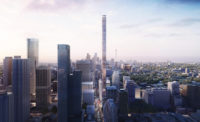The biggest project of Frank Gehry’s career is moving ahead in his hometown of Toronto—and reaching new heights for the architect and for the city.
Known as Mirvish + Gehry, the mixed-use complex reached a milestone in January when developers submitted a final version of the scheme for city approval. It features a pair of irregularly shaped towers that dance their way up to 1,079 and 990 feet tall.
The project was launched in 2012 by David Mirvish, a theater producer and art collector whose father, retailer Ed Mirvish (a longtime friend of Gehry’s), began acquiring the downtown property half a century ago. David Mirvish’s initial proposal for three towers faced vocal opposition from city planners for its density in this crowded area and because it would have meant demolishing the 2,000-seat Princess of Wales Theatre. After Mirvish reduced the project to two towers and agreed to save the theater, he won city approval in 2014. Mirvish sold the development to Great Gulf and its partners Westdale Properties and Dream corporation in 2017.
If completed, the 1.84 million-square-foot complex would be the largest and the tallest Gehry has built so far, substantially taller than his Spruce Street tower in New York, which is 890 feet high. The two buildings, 91 and 81 stories respectively, will have a dominant place in the skyline—edging out a planned Foster & Partners tower called the One, slated for completion in 2022, and the 1975 First Canada Place office tower by Edward Durell Stone—to become the tallest buildings in Toronto.
Gehry was born Frank Goldberg in the Canadian city in 1929, and lived there until moving to Los Angeles in his teens. For him, the project has personal resonance. “I feel good about Toronto and about my Canadian roots,” he said in an interview. “My DNA still wobbles when I get here.”
Gehry has imagined two distinct and distinctive towers, reaching out to each other with sculptural canopies that span a side street. Each is basically L-shaped in plan but expands as it rises, with cantilevered bumpouts. Both buildings comprise offset blocks that evoke the form of nearby lofts. “I’m trying to break it up and show that you can do towers that relate to the scale of the old city of Toronto,” Gehry said.
The design of the complex sees the architect in a collagist mode. The facades include flat curtain wall, a rippling metal surface that Gehry likens to a waterfall, and metal cladding (either titanium or stainless steel) with punched windows. “The variety of materials was important, so the buildings don’t read like every other skyline glass thing,” said Gehry, “and I think having the two buildings talk to each other—that’s an opportunity you don’t get very often.”
Luxury condos will occupy the bulk of the towers, along with a 209-room hotel in the west tower. The development also includes a theater, studios, and classrooms for OCAD University’s (formerly the Ontario College of Art and Design) visual-arts program, and retail space. David Nam, a partner at Gehry Partners who is overseeing the project, compares it to Rockefeller Center in its scale and variety of uses.
The project’s long gestation has raised questions about whether it will actually proceed; now the developers say they plan to begin marketing condo units this year. The other concern is whether meaningful architecture can survive the cost pressures of the development process. “It’s tight, but it can be done,” Gehry said. “Most developer clients are just afraid of the unknown. If you do something slightly different, they ask, is this going to have a cost impact? But if you can prove it won’t, and if the changes you make are adding value, which they are, then why not?”




Post a comment to this article
Report Abusive Comment